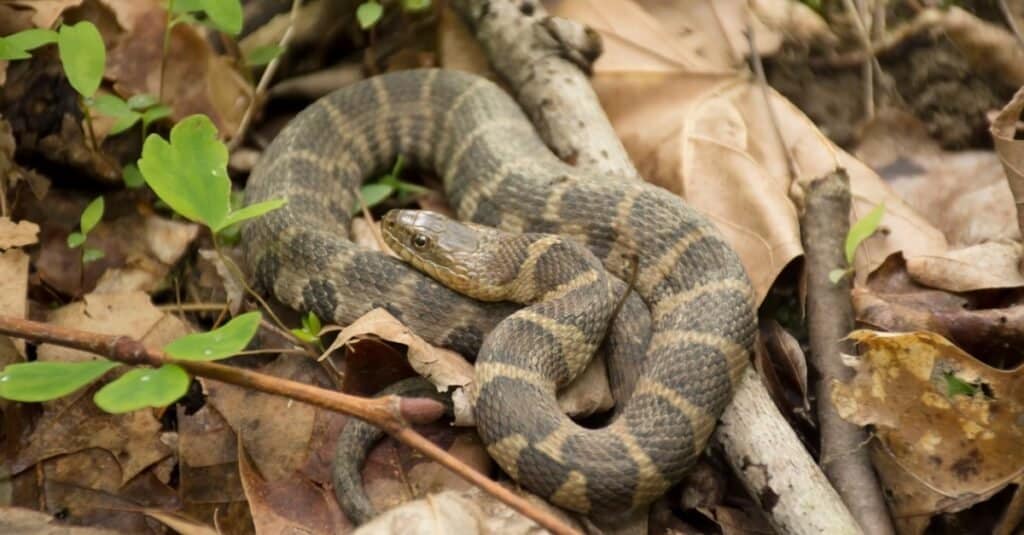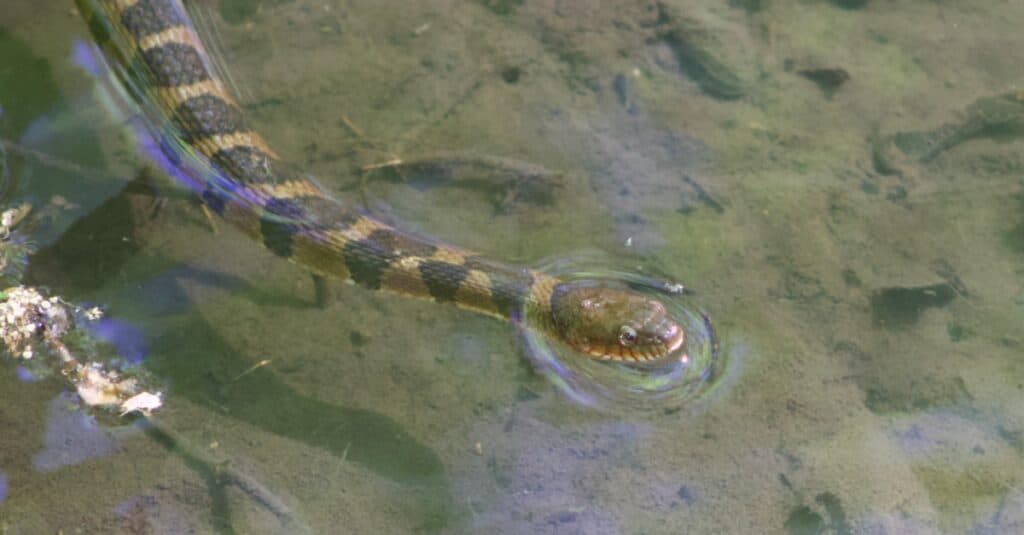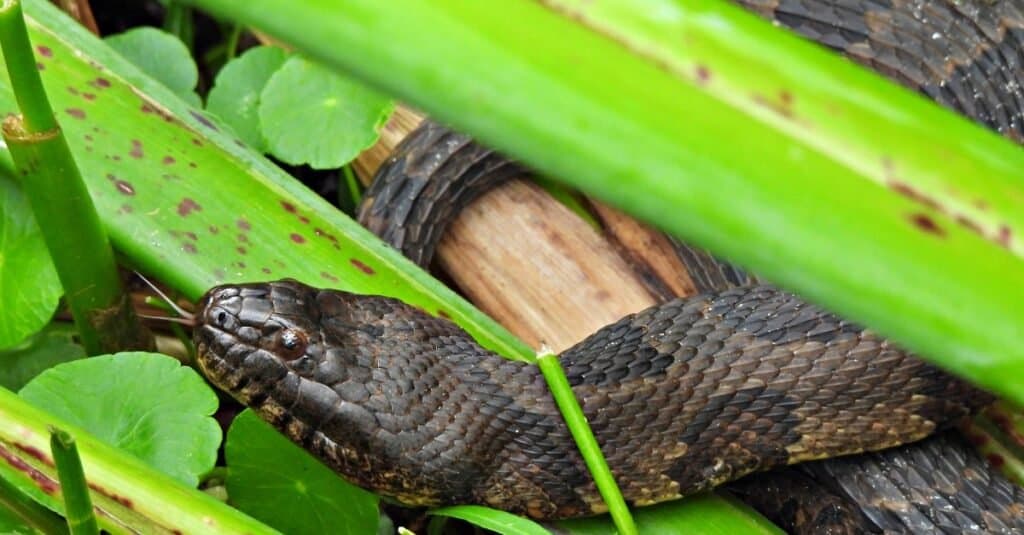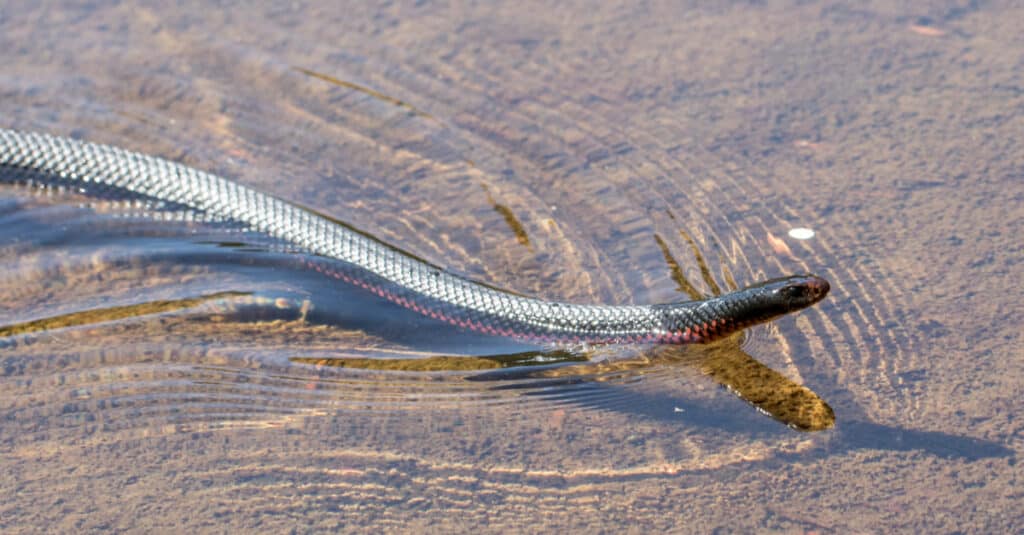When you own or live near a body of water, running into all kinds of wildlife is an inevitable occurrence. Although most of them will be harmless critters seeking water, you will almost certainly come across a snake or two. Northern water snakes are non-venomous snakes that enjoy spending time in the water, as their name implies.
These snakes aren’t venomous or dangerous, but they are known for being aggressive. Even if you don’t touch them, they might turn hostile when approached. Water snakes are also not constrictors. They swallow their prey alive.
They wait for it to pass by with their mouths wide open, then snap their jaws around it.
Water Snake Bites

Water snakes tend to bite when disturbed.
©iStock.com/IcemanJ
The nonvenomous water snake has an aggressive reputation, but that is incorrect. They are extremely defensive, but will always choose flight whenever possible. It’s only when you pick them up that biting is an option. When they flatten their bodies and jaws, it means they trying to look bigger so you’ll leave them alone. A water snake’s bite can be painful because their teeth are very sharp. But, other than a few bleeding bite wounds, you shouldn’t have any other issues.
A water snake’s bite is easy to spot since there would be multiple tooth marks, all of which would be the same size. Their rows of tiny teeth do more than scratch the skin, as they have anticoagulants in their saliva. Anticoagulants prevent blood clotting, resulting in more bleeding than expected from a typical snakebite. These proteins may cause a hazard to their small-bodied prey, as they can help the water snake follow its prey’s blood train if it escapes. The good thing is that their anticoagulants pose little risk to larger animals and humans.
Are Water Snakes Dangerous to Humans?

Water snakes don’t have venom, so they are generally not dangerous to humans.
©iStock.com/Dalene Capps
These snakes give many people pause, but northern water snakes are common snakes that cause no harm. Water snakes aren’t generally dangerous to humans because they don’t have venom. As with all non-venomous snakes, they tend to escape or swim away as their first option. Humans are not part of their natural diet, so there is no reason to fear getting attacked.
Like nearly all other snakes, water snakes are truly more afraid of you – humans are not on their menu, but we are threats to their safety. Simply giving a water snake a little space will keep you from being bitten as they slip off into the water.
Treat the scrape or scratch as though it were any other scrape or scratch: wash with soap, and bandage if needed. Most water snake bites result in pain and swelling around the wound. In some cases, bites might even produce an allergic reaction. You can seek medical advice if this happens.
Many water snakes look like venomous snakes. As a result, harmless water snakes die by hundreds each year because people, possibly with good intentions, think they are killing a deadly snake when they are not. So, unless you can confidently, quickly, and accurately identify a snake, it is advisable to treat it with respect and give it space to avoid any potential harm to each other.
Are Water Snakes Venomous?

Though water snakes are often confused with cottonmouths, northern water snakes are not venomous.
©iStock.com/passion4nature
Northern water snakes are not venomous. However, water snakes are frequently confused with venomous cottonmouth snakes, also known as water moccasins. Knowing the difference between a harmless water snake and a water moccasin is critical. Otherwise, it might cause serious consequences.
Examining their heads and necks is a viable method to tell them apart. Water moccasins have blocky, heads with sharp angles and thick, stocky bodies for their length. They also have a much thinner neck. They are known for their ‘cotton mouth’ because the inside of their mouth is white, which they typically reveal as a gesture of defense. On the other hand, water snakes have a narrower, round head, a longer, more slender body, and a less distinctive neck.
The evolutionary adaptation of the water snakes to avoid predation could explain the two species’ resemblance. Unfortunately, water snakes are sometimes mistaken for the deadly cottonmouth snake, and as a result, killed unnecessarily.
Can a Snake Bite You In or Under Water?

Red-Bellied black snakes, native to Australia, are known to hunt in shallow water
©Ken Griffiths/Shutterstock.com
Snakes are capable of biting underwater, although it typically occurs when they are provoked or perceive a threat.
In fact, a study published in the Tropical Journal of Medicine and Hygiene examined 100 patients who had suffered sea snake bites and sought treatment at a local hospital. Surprisingly, the research revealed that more than 80% of these patients were fishermen who had been in the water at the time of the incident.
While snakes can in fact bite underwater, snakes cannot breathe underwater, as that would categorize them as fish. While some snakes, like the Anaconda, can hold their breath for extended periods, they do not extract oxygen from the water. Snakes lack gills and do not have the ability to breathe underwater.
Water Snakes’ Habits and Diet
Water snakes like to hunt around or in the water, eating amphibians, fish, frogs, toads, and salamanders. When water snakes reach a length of around 1.5 feet (45 cm), they switch from fish to larger animals like salamanders and toads. Smaller water snakes will continue to eat fish as a primary source of nutrition.
After overwintering, northern water snakes only socialize in the fall and spring. They curl around basking spots in groups. They are more solitary creatures, especially during the summer months. Water snakes like to sun themselves on overhanging branches, pathways, beaver lodges, dried cattail stems, and various shallow areas in the river. It is possible to see northern water snakes during the day and night. However, they are more active during the daytime.
How to Avoid Water Snake Bites
If you see a water snake flattening its body and jaws, it is preparing to bite. Leave the snake alone and get as far away as you can when you see this. Despite their length of up to five feet, these snakes are not constrictors like boas and pythons. Instead, they consume their prey while it’s still alive, swallowing it whole. Like most animals, water snakes play a crucial part in keeping nature balanced.
Always watch where you step when moving through tall grass or weeds and poke the ground to scare away the snakes. If you wish to swim in areas where you know snakes lurk, you’ll want to know everything you can about them. Snakes can bite you underwater, but only if provoked or if they’re afraid of being harassed. Always remember, it is best to assume every snake is a venomous snake to avoid danger.
The photo featured at the top of this post is © iStock.com/passion4nature
Discover the "Monster" Snake 5X Bigger than an Anaconda
Every day A-Z Animals sends out some of the most incredible facts in the world from our free newsletter. Want to discover the 10 most beautiful snakes in the world, a "snake island" where you're never more than 3 feet from danger, or a "monster" snake 5X larger than an anaconda? Then sign up right now and you'll start receiving our daily newsletter absolutely free.
Thank you for reading! Have some feedback for us? Contact the AZ Animals editorial team.






